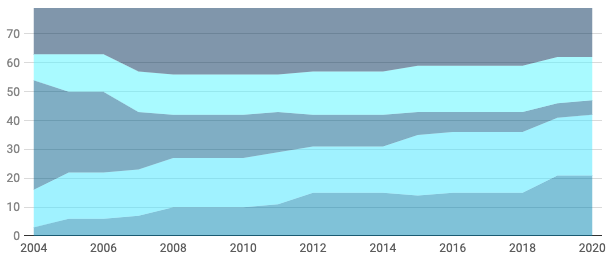I blogged the other day about Victoria’s system of independent reviews of each council’s electoral structure (the number of wards and the number of councillors elected per ward).
This system has existed for at least two decades, and over that time it has caused a transformation in terms of how Victoria’s council wards are structured. I’ve pulled together a dataset of every review under this system since 2003 (those published on the VEC website) and have identified trends in this data.
You can look at this data yourself here.
Through this data you can see how this system has gradually, through local independent processes, revealed a preference for multi-member wards that voters are generally more happy with, and tends to not be reversible. It can help you understand why forces opposed to proportional representation have needed to change the process to get their way.The review process allows for submissions from the public about the appropriate number of councillors for each council, the number of councillors to be elected for each ward and the best way to divide up the area into wards. I’ve collected 160 individual reviews, which averages out to two reviews for most councils. 86 of these reviews involved some change to the structure of wards.
I’ve included 31 reviews conducted since 2019 which are still waiting for approval from the minister. I’ve included these in the analysis as if they have been implemented, to give you a sense of where the trend was headed if the parliament hadn’t intervened to change the process last week.
Single-member wards were the standard method of electing councils in Victoria up to the early 2000s, particularly in metro Melbourne. 42 out of 79 councils used single-member wards, and another 12 had a mixture of single- and multi-member wards. 13 were elected at-large, with another 12 using multi-member wards. 24 out of 31 metro-area councils used single-member wards.
Legislation was changed in 2003 or 2004 to allow for the use of proportional representation beyond the City of Melbourne. Prior to this time, the rare multi-member wards and undivided council areas were elected with a majoritarian preferential system with similarities to the old preferential block vote used to elect the Senate prior to 1949 (the detail is unclear).
Since that change we’ve seen a big shift away from single-member wards towards multi-member wards, to the point where only five councils were on track to exclusively use single-member wards at the 2020 election. There has been a slight uptick in the number of councils using a mix of single- and multi-member wards but overall the number of councils using proportional representation has increased dramatically, from 32 to 59.
This chart shows the number of councils in each category over the last sixteen years. Councils using multi-member wards are split between those with equal-sized wards and those with wards electing different numbers of councillors.
There has also been a consistent trend where councils that have switched to multi-member wards (or undivided councils, where the council is a single ward) very rarely switch back. The following table shows the outcome of reviews based on the previous system.
| New structure | ||||
| Previous structure | Multi | Mix | Single | Total |
| Multi-member | 70 | 5 | 1 | 76 |
| Mix | 10 | 15 | 1 | 27 |
| Single-member | 30 | 9 | 18 | 57 |
| Total | 110 | 30 | 20 | 160 |
- When a council with single-member wards is up for review, that structure only survives in 31.6% of cases (18 out of 57). In contrast, councils with all multi-member wards (including one-ward councils) have stuck with PR in 92% of cases.
- Only two councils which had some form of multi-member wards (sometimes alongside single-member wards) were switched to single-member wards, out of 103 cases.
- This review process has also produced a slight increase in total councillor numbers over time (from 625 in 2004 to 651 under the proposed representation reviews in 2019 and 2020), with a tendency to increase a council’s size becoming more common in recent years. From 2004 to 2011, 17 councils had their size reduced, while 19 were increased. Since 2012, 13 councils have been recommended to have their size increased, while only one was reduced.
- You can also see the shift in model if you look at the ratio of councillor to ward. Since 2003, 67 reviews have recommended an increase in the ratio (ie. drawing wards which elect more councillors than before) while only 13 recommended a reduction in the ratio.
- The overall ratio has increased from 1.51 in 2004 to 2.59 now. This same trend can be seen in the decline in the number of wards across the entire state, from 414 wards in 2004 to just 251 in 2020.
- This trend has completely transformed the state of local government elections in Victoria, all without any rule preferring proportional representation. Local consultations have just tended to reaffirm proportional voting systems and lead to change away from single-member wards and towards fewer and larger wards. It will be interesting how dramatic the shift will be with the change in the system last week.



